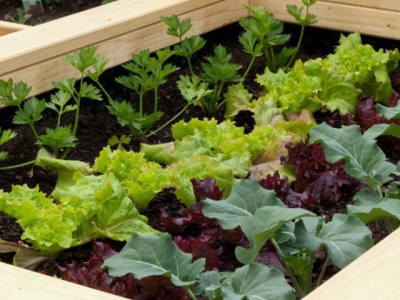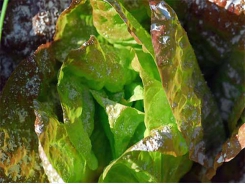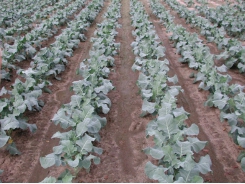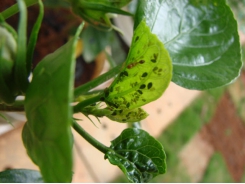How to Grow a Small-Space Vegetable Garden

Are you hungering for some home-grown vegetables, but short on space? Does the sun shine brightest in the front of your property or close to the house? Well no need to pass on the pleasures of gardening. There are plenty of delicious, hardy vegetables that thrive in decorative containers, small raised beds and tiny strips of land.
BEFORE CHOOSING VEGETABLES CONSIDER YOUR GARDEN CLIMATE
Each region of the country has particular vegetables that are easier to grow, or thrive during a certain time of year. If you live in the South, eggplants and peppers will have a wonderful long growing season. In the North, broccoli, peas and lettuce do well, but tomatoes can be fussier.
Gardening in dryer climates requires special care to ensure that plants receive enough moisture, while wet climate gardeners must watch for mildew and other diseases, even in small space gardens.
DECIDE ON THE BEST LOCATION
Perhaps your front porch is loaded with afternoon sunlight, or a patch of land next to the garage seems perfect for growing a small space garden. If you live in an apartment or have no land to spare, you can still enjoy the season’s bounty as long as you have a sunny deck and some large planting pots.
Keep in mind that while most vegetables do best in, at least, 6 hours of sunlight, there are a few that can tolerate some shade (spinach, lettuce), so don’t discount a potential garden spot that slumbers in late afternoon.
PREPARE A WELCOMING SPACE FOR YOUR VEGETABLE GARDEN
Raised beds and large containers make excellent homes for small gardens. To establish a bed, you can either purchase a pre-constructed frame made from wood or composite material, or build one with untreated boards, decorative bricks or stones. The ground should be leveled and weeded before you set in the frame, then covered with planting cloth, unless the natural soil is to be included in your garden.
Large container gardens can be both decorative and practical. Leafy, variegated greens look beautiful sitting along a porch or deck and, since you will be clipping and harvesting often, they can accommodate a bit of crowding.
Whether you plant your vegetables in beds, pots or directly into the ground, the soil must be well-balanced with a mixture of top soil and organic material such as compost, aged manure and peat moss. Depending on the size of the garden space and the quality of the initial soil, amendments may comprise 30 percent or more of the growing material.
Try to prepare your soil at least 3 weeks before planting time to give the garden area time to mellow.
VEGETABLES THAT THRIVE IN SMALL SPACES
Beets are easy to grow and do not take up much room. They enjoy summer sunlight and tend to be problem-free in all climates. They do well when started from seed, and may produce small vegetables within 2 months. Look for ‘Gladiator’ or ‘Little Ball ‘varieties.
Carrots are excellent for small garden spaces but do not thrive in hot weather. In warmer climates they can be planted as early as March, but it is best to wait until May in cooler zones. They can also be replanted in late summer and harvested until early winter. Salad carrots should be ready for picking within 10 weeks of planting. For small varieties try ‘Lady Finger’ or ‘Gold Nugget’.
Lettuce is always a space saver and does beautifully in pots as well as raised garden beds. The plants love the cooler months of the season, and seeds can go into the ground as early as March, with continuous plantings for ongoing harvest. ‘Little Gem’ and ‘Tom Thumb’ are small greens that may produce salad-ready leaves within 8 weeks.
Peppers take up very little space and look beautiful in decorative containers. Hot varieties are especially ornamental. In many climates peppers do best when started from plants. Warmer climates may plant in March, while cooler zones should wait until May.
Scallions are disease resistant, love the cooler months of the season, and grow wonderfully from seed in the springtime. Plant them in March/April for a harvest by mid-June. Try ‘White Portugal’ for a small white onion that yields well in small garden spaces.
Tomatoes are a sun-loving favorite that produces well with some tender, loving care. Many gardeners prefer to start with plants, rather than seeds, to shorten production time. Soil must be rich with organic matter. Planting should be in late springtime, and the tiny angular shoots that grow between the stems must be pruned throughout the garden season.
If you are planting a number of plants in a small space, try to stake or cage them early so they grow upright without too much sprawl. ‘Patio’, ‘Tiny Tim’, ‘Small Fry’, ‘Pixie’ and ‘Patio’ are good varieties to look for.
Herbs, such as parsley and chives, make excellent growing companions alongside vegetables, especially lettuce. The key is to keep them well-manicured and on their best behavior, so your small-space garden remains productive and healthy all season long.
Có thể bạn quan tâm
Phần mềm

Phối trộn thức ăn chăn nuôi

Pha dung dịch thủy canh

Định mức cho tôm ăn

Phối trộn phân bón NPK

Xác định tỷ lệ tôm sống

Chuyển đổi đơn vị phân bón

Xác định công suất sục khí

Chuyển đổi đơn vị tôm

Tính diện tích nhà kính

Tính thể tích ao hồ




 10 Easy Soil Tests That Pinpoint Your Garden's…
10 Easy Soil Tests That Pinpoint Your Garden's…  Biological control of aphids
Biological control of aphids